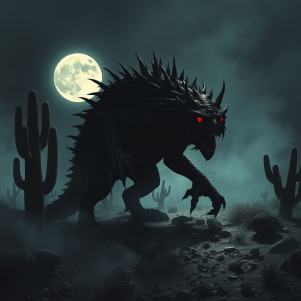
The Chupacabra, a legendary creature said to inhabit parts of the Americas, has been a topic of fascination for many years. The name “Chupacabra” comes from the Spanish word “chupar,” meaning “to suck,” and “cabra,” meaning “goat,” which refers to the creature’s alleged habit of attacking and drinking the blood of livestock. But where did this legend originate, and what are its roots in Mexican folklore?
A Brief History of the Chupacabra Legend
The modern concept of the Chupacabra originated in Puerto Rico in the 1990s, where farmers reported finding their livestock dead, with puncture wounds in the neck and all the blood drained from their bodies. The creature was described as being 4-5 feet tall, with spiky, reptilian skin, and a row of spines or quills running down its back. However, similar creatures have been described in Mexican folklore for centuries, suggesting that the Chupacabra legend has much deeper roots.
Mexican Folklore and the Chupacabra
In Mexican folklore, there are several creatures that bear similarities to the Chupacabra. One of the most notable is the “Cadejo,” a mythical creature said to roam the countryside, preying on livestock. The Cadejo is often described as a large, dog-like creature with glowing eyes, and is said to have a strong, unpleasant odor. While the Cadejo is not typically associated with bloodsucking, its reputation as a predator of livestock makes it a possible precursor to the Chupacabra legend.
Another creature from Mexican folklore that may have influenced the Chupacabra legend is the “Nahual,” a shapeshifter said to have the ability to transform into various animals, including dogs, cats, and birds. In some stories, the Nahual is said to have a strong connection to the supernatural, and is often associated with witchcraft and sorcery. The idea of a creature that can transform into different animals, and has a connection to the supernatural, may have contributed to the Chupacabra’s reputation as a mysterious and elusive creature.
Ancient Roots: The Aztecs and the Mayans
The Chupacabra legend may also have roots in the mythology of the Aztecs and the Mayans, two ancient civilizations that flourished in Mexico and Central America. In Aztec mythology, there is a creature called the “Camazotz,” a bat-like god associated with sacrifice and bloodshed. The Camazotz was said to have the power to drain the blood of its victims, and was often depicted as a symbol of death and destruction.
In Mayan mythology, there is a creature called the “Ah Puch,” a god of death and decay who was often depicted as a skeleton or a corpse. The Ah Puch was said to have the power to control the forces of nature, and was often associated with bloodshed and sacrifice. While the Ah Puch is not directly related to the Chupacabra, its association with death and bloodshed may have influenced the development of the legend.
Conclusion
The Chupacabra legend is a complex and multifaceted phenomenon, with roots in Mexican folklore and ancient mythology. By exploring the history and cultural context of the legend, we can gain a deeper understanding of the creature’s significance and symbolism. Whether or not the Chupacabra actually exists, its legend has become an important part of modern mythology, reflecting our deepest fears and anxieties about the natural world and the supernatural. As we continue to explore and interpret the Chupacabra legend, we may uncover even more secrets about the ancient roots of this fascinating creature.
References
For further reading on the Chupacabra legend and its roots in Mexican folklore, see:
- “The Chupacabra: A Study of the Legendary Creature” by Corrales, J. (2013)
- “Mexican Folklore: A Guide to the Myths and Legends of Mexico” by Ledesma, A. (2015)
- “The Aztecs: An Very Short Introduction” by Matos Moctezuma, E. (2013)
- “Mayan Mythology: An Encyclopedia” by Nicholson, I. (2015)
